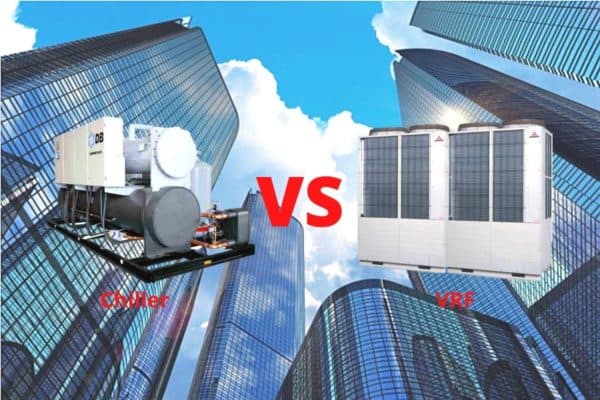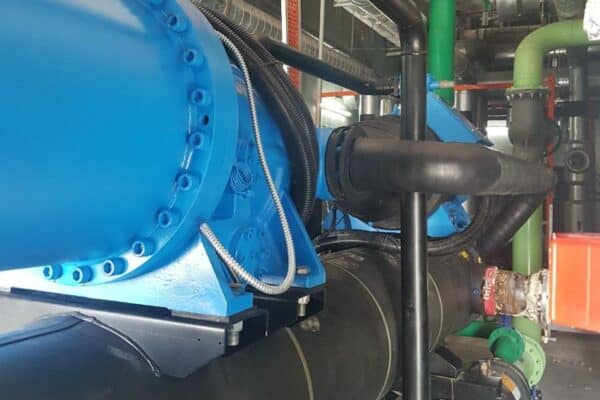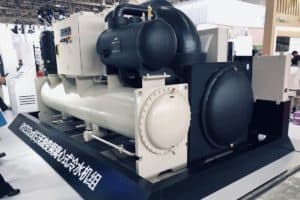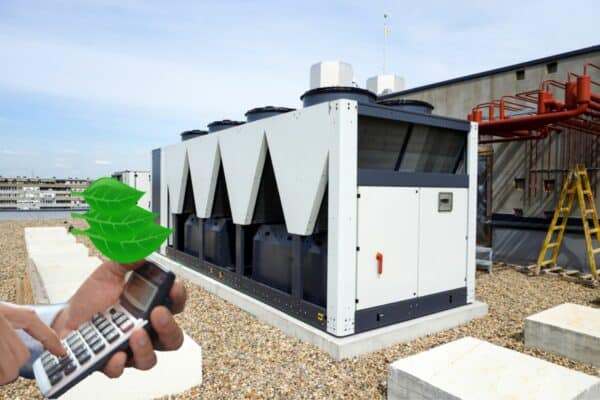9 Chiller Energy Saving Tips (for Existing System)
Many people wish to save more energy on their chillers. However, some of them either don’t know or do it wrongly, causing their chillers to consume even more power. I’ve learned some of the fundamentals of chillers and hence, I’ll share some of the energy-saving tips for existing systems.
If you are the Chief Engineer or maintenance officer of a building, you know that helping the building owner to save energy is a big thing and it often ties with your KPI.
After all, the more energy you save, the more profit the building owner gets and thus, you may have a sweet bonus next year.
Modern chilled water systems are designed efficiently. But, they can become very inefficient due to poor operation and maintenance that might not be at your fault. So, how can you improve the energy efficiency of your chillers?
1. Don’t Slow Down Your Condenser Pumps
Many people try to save energy on pumps by reducing their speed. However, they don’t realize that reducing condenser pump speed is doing more harm than good.
Chillers are more efficient when their refrigerant condensing pressure is low. Since pressure is directly proportional to temperature, low refrigerant condensing temperature is good for chillers.
By slowing down the condenser pumps, the condenser water flow rate is reduced. Since water flow rate is inversely proportional to water temperature, the slower the water flow rate, the higher the condenser water return temperature.
When the condenser water return temperature is high, it will not bring down the chiller’s refrigerant condensing temperature at the chiller condenser tube. Hence, your chillers will have a high refrigerant condensing temperature.
Ultimately, your chillers’ refrigerant condensing pressure will be increased and the efficiency of your chillers will be reduced, leading to high power consumption on your chillers that offsets the energy saving from your condenser pumps.
So, do check again if you’ve slowed down your condenser pumps. Your chillers may be running inefficiently now and your overall electricity usage may be higher than before.
2. Check Your Chiller Condenser Tubes
Chiller condenser tubes naturally build scales quicker than chiller evaporator tubes. However, many people don’t check and clean their chillers’ condenser tubes regularly. Most of them only clean the tubes when there is a problem.
When your chiller condenser tubes are dirty, the heat transfer between the condenser water and the refrigerant is not effective. Thus, your chiller condenser water approach temperature is higher than 4°C (7.2°F).
Chiller approach temperature is the temperature difference between the chilled/condenser water and the refrigerant.
If you have perfect cooling towers, you’ll have a good condenser water return temperature. However, poor heat transfer at the chiller condenser tubes is causing high refrigerant condensing temperature/pressure and chillers are not efficient when their refrigerant condensing temperature/pressure is high.
Thus, do check your chiller condenser tubes if you haven’t already. They may be very dirty now, causing your electricity bill to shoot up every month.
3. Check Your AHUs Cooling Coil
Most of the time, the AHUs filter is clean but the cooling coil is not. Sometimes, it is difficult to service the AHUs cooling coil due to space and operation constraints. But, not cleaning the coil will lead to a high electricity bill.
When AHUs cooling coil is dirty, the heat transfer between the chilled water and the indoor air is not efficient. Thus, they may result in low chilled water return temperature.
If you have a low chilled water return temperature, you have a low delta T problem which is causing your chiller to run inefficiently.
Low chilled water return temperature will not release much heat back to the refrigerant at the chiller evaporator tubes. Hence, it’ll result in low refrigerant evaporating temperature/pressure and chillers are not efficient when their refrigerant evaporating pressure is low.
So, if you have not cleaned your AHUs’ cooling coil lately, it’s about time to get your team to check and clean them. You’ll fix the low delta problem and get your chillers back to running efficiently.
4. Don’t Reduce Your Cooling Tower Fan Speed
Many people try to save energy by reducing their cooling towers’ fan speed. However, they don’t realize that by doing so, they may be causing more energy usage on their chillers.
When the cooling tower fan speed is reduced, the airflow is reduced. Hence, the heat transfer between the condenser water and the ambient air is reduced, causing a high condenser water return temperature.
Chillers are not efficient when the condenser water temperature is high because their refrigerant condensing pressure is high thereby reducing their capacity and increasing the power input to their compressor.
By reducing the fan speed of your cooling towers, you can save some energy from the fan motor. However, increasing the refrigerant condensing pressure of your chillers is costing you more money.
Hence, check again if your cooling towers are running slow and if the condenser water return temperature is high. You may have inefficient chillers that are causing a high electricity bill to the owner every month.
On a side note, if you want to quickly learn about chilled water system, you can get my Chilled Water System (eBook). If you’re into design, you can enroll in my Chilled Water System Design Course where I teach you various design procedures with tons of examples.
Chilled Water System Design Course
Learn how to design a chilled water system with AHU/FCU selection, chiller sizing, cooling tower sizing, pump sizing, piping design, ductwork design and more.
5. Replace Faulty Chilled Water Valves
Many owners are not willing to fork out for chilled water valves replacement. So, you may have already forced some of the FCU valves fully open all the time and you know that the electricity bill is high because of that.
However, you can try to explain to the owner that if many chilled water valves are forced to open all the time, too much chilled water is running into FCUs and AHUs which leads to low chilled water return temperature.
AHUs and FCUs control their cooling power by regulating their chilled water valve thereby controlling the amount of chilled water going into their cooling coil. They need to ensure that they return a decent chilled water temperature back to the chillers so that the chillers don’t waste energy on producing too much chilled water.
If AHUs and FCUs are returning low chilled water temperature back to the chillers, the refrigerant evaporating pressure of the chillers is high. Hence, the capacity of the chillers is reduced and the power input of the chiller compressor is increased.
By replacing faulty chilled water valves, chillers will not waste energy on producing an unnecessary amount of chilled water and thus, saving power and electricity at the same time.
6. Check Your Cooling Tower Fan and Infill
Many cooling towers have dirty fans and infill because people tend not to service their cooling towers due to inconveniences and difficulties since cooling towers are tall.
When the cooling tower fan and infill are dirty, the heat exchange between the condenser water and the ambient air is not effective. Hence, the condenser water temperature returning back to the chillers is high.
High condenser water return temperature leads to high refrigerant condensing temperature/pressure. Chillers are not efficient when their refrigerant condensing pressure is high because their capacity is reduced and compressor power usage is increased.
So, check and clean your cooling towers fan and infill if you haven’t done it lately. After that, your chillers will be running efficiently and the electricity bill will be lower.
7. Inspect All AHU Thermostats
There are a lot of thermostats in a building. Over time, some thermostats will spoil and malfunction. These faulty thermostats are not controlling the amount of chilled water flowing into cooling coils appropriately.
When AHUs and FCUs are getting too much chilled water flowing inside their cooling coil, they can’t increase the chilled water return temperature because the room temperature is already cold.
Hence, the chilled water returning back to the chillers is low in temperature. When the chilled water return temperature is low, the refrigerant evaporating temperature/pressure is low.
Chillers are not efficient when their refrigerant evaporating temperature/pressure is low because their capacity will be reduced and their compressor will be consuming more power at the same time.
Hence, do inspect your AHUs thermostat regularly to ensure that they are closing their chilled water valve when the setpoint temperature is reached. Otherwise, replace them so that you maintain the efficiency of your chilled water system.
8. Increase the Chilled Water Supply Temperature (Caution)
Many people knew that by increasing the chilled water supply temperature, their chillers are running more efficiently. It is a common practice to improve the energy efficiency of chilled water systems.
However, you need to be very careful when increasing the chilled water supply temperature, especially in humid places because you’ll need to dehumidify more in order not to cause mold and fungus growth issues.
AHUs and FCUs dehumidify by condensing the water vapor in the air. In order for condensation to happen, the surface temperature of the cooling coil of AHUs and FCUs must drop below the dew point of the air. Otherwise, condensation will not occur and dehumidification will not take place.
But, if you increase the chilled water supply temperature, you also increase the cooling coil surface temperature which also reduces the dehumidification capability of AHUs and FCUs.
To know more about the relationship between water temperature and chiller performance, check out this post where I outlined the fundamental and principle of chiller capacity and efficiency.
If you increase the chilled water supply temperature too much, the humidity level in your building may be too high, encouraging the growth of mold and fungus.
Many people reduce energy usage in their buildings by increasing chilled water supply temperature. However, they never check the humidity level and they wonder why mold and fungus are growing everywhere in their building.
So, if you want to increase the chilled water supply temperature, you should check the humidity level in your building to make sure that you don’t increase the humidity level too much.
9. Replace Your Chillers
Many owners simply don’t have a budget or are not willing to pay for chillers replacement. They rather let their inefficient old chillers use a great amount of power, causing high monthly electricity bills.
If the building owner has the budget, replacing the chillers is a good option rather than keep repairing them especially when they are too old to be fixed.
Sometimes, it is hard to convince building owners to replace their chillers especially when they really don’t have the budget. However, you can look for companies who do ESPC (energy-saving performance contract) and propose to change their chillers through ESPC.
Energy Saving Performance Contract
An energy-saving performance contract (ESPC) is a 3-5 years contract that building owners sign with a company to allow the replacement of expensive equipment at zero capital cost. Upon replacement, the company will take profit from building owners based on a portion of the amount of saving yield by the new equipment.
Usually, an ESPC company will do a free energy audit on your chilled water system. Then, they’ll submit to you a contract that may last 3-5 years or even 10 years depending on the current performance of your system. If your system has very poor performance, the company can take more profit and thus, the contract period can be shorter.
Most ESPC companies guarantee the amount of saving you can get by replacing new equipment. Thus, securing your saving and their profit. However, some ESPC companies do it based on calculations and projections which you’ll need to be extra careful.
After you sign the contract, the ESPC company will do whatever is necessary to improve the energy efficiency of your system including chillers replacement. Upon replacement, your new system should be running way more efficiently than your old system.
Hence, your monthly electricity bill should be significantly lower than in the past months. A portion of your monthly electricity bill savings will go to the ESPC company and the rest is realized by you.
Therefore, you can get your old chillers replaced at zero capital cost and enjoy savings every month.
Once again, you can get my Chilled Water System (eBook) to quickly learn more about chilled water system. But, if you want to learn how to design a chilled water system from start to end, I encourage you check out my Chilled Water System Design Course.
Chilled Water System Design Course
Learn how to design a chilled water system with AHU/FCU selection, chiller sizing, cooling tower sizing, pump sizing, piping design, ductwork design and more.
If you have anything to add (or ask) about this topic, leave a comment down below!








